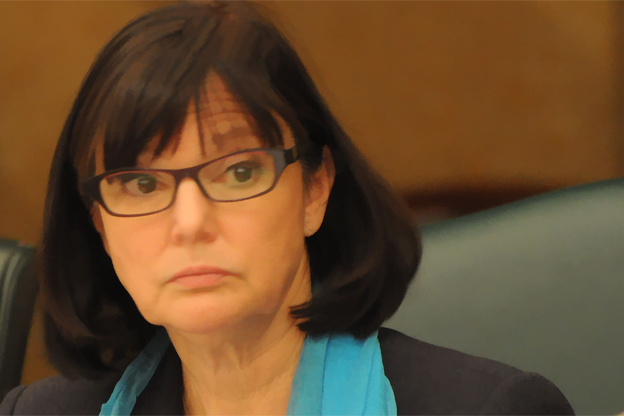

And along comes Terri!
Well, and Jenifer, too!
The pack of legislative beagles’ panting and baying in pursuit of the teaching profession continue unabated. Two of the lead beagles at the moment are Sen. Teri Bonoff and Rep. Jenifer Loon, a pair of cosseted suburban dilettantes whose principal credential here is that, once upon a time, they both went to school. You can check their bios if you don’t believe me.
You shouldn’t be surprised, though, because the entire education “reform” movement is chock-a-block with people who are ciphers in the field of education. Take Bill Gates, for example, who decided that we needed to break up big high schools to improve student performance. Here’s what happened:
[ ] From 2000 to 2009, he spent $2 billion and disrupted 8 percent of the nation’s public high schools before acknowledging that his experiment was a flop. The size of a high school proved to have little or no effect on the achievement of its students. At the same time, fewer students made it more difficult to field athletic teams. Extracurricular activities withered. And the number of electives offered dwindled.
C’est la vie, eh, Bill?
And Gates is hardly alone; any officious twit, especially one with a lot of money, or a position of power, can play. According to professors at the University of Illinois:
The people most often cited as “education experts” in blogs and news stories may have the backing of influential organizations – but have little background in education and education policy, a new study suggests.
The findings are cause for concern because some prominent interest groups are promoting reform agendas and striving to influence policymakers and public opinion using individuals who have substantial media relations skills but little or no expertise in education research, say the authors of the study, Joel R. Malin and Christopher Lubienski, both at the University of Illinois.
Loon and Bonoff have decided that it would be swell to lay teachers end to end and pretend we’ve solved education disparities and achievement gaps. It would, in the words of Rep. Loon, “ensure every Minnesota child receives a world-class education.” That’s sales puffery that would make even the car salesman from Crown blush.*
There was another story about this rancid buddy movie at the Legislature in the Strib again on Sunday, February 22nd. The story breathlessly reports that in a layoff situation, in the case of two teachers with equal seniority, the layoff might be decided by a coin toss! Rep. Loon decries this and the Strib picks up the cudgel.
But many of you probably know that a tied election is determined by the appropriate canvassing board by lot. There was a Cook County Commissioner chosen by lot last fall. It happens once in a while. Check your archives, Strib.
The Strib story does point out that state law allows school districts to bargain for and choose methods other than seniority for deciding layoffs, but most choose not to. Why do you suppose that is? One DFLer in the House put his finger on it:
Rep. Tom Anzelc, DFL-Balsam Township, a veteran educator, said basing layoffs on peer-conducted evaluations as the evaluation law requires would result in a “contentious back-and-forth, teacher on teacher, teacher on administrator, teacher on school-board member, animosity, which is going to be a really big deal for every lawyer on Main Street who has a shingle up.”
Now, I don’t necessarily appreciate Anzelc’s kicking the shingles off the roofs of lawyers, but he’s got a point. What if you have, say, two teachers with equal seniority, and one of the teaches at Bethune and the other one teaches at Hiawatha? That’s not the situation in the two teacher profiles in this earlier article in the Strib, but it might be.
Which teacher is likely to look better? Which one is likely to have a room with the better test scores?
– o O o –
Now consider this from the Department of Education’s model student goals (8/2013, page 5):
The assessment(s) used. The goal should include assessments both to track student progress and make midcourse corrections (formative), and to indicate if the goal was achieved or to what extent the goal was achieved (summative). Guidance for choosing and approving assessments are provided to ensure that all teachers utilize [why not use the two-dollar utilize instead of the fifty-cent use?] assessments that to the greatest extent possible:
o Are aligned to content standards
o Assess student growth across a wide range of performance levels
o Are valid, reliable, and specific
o Capture proficiency as well as true mastery of skills, including higher-order thinking skills
o Provide data that can, as much as possible, be attributed directly to teacher efforts
o Include the potential for accommodations and modifications when appropriate
The model is 28 pages of this gibberish. My favorite part, though is the item that reads:
Provide data that can, as much as possible [emphasis added], be attributed directly to teacher efforts
But if it can’t? What the hell? Use it anyway. Right?
– o O o –
There are people, including people who ought to know better, who say that teachers are just worried about their jobs, and this is “about the children.” Of course they’re worried about their jobs. They’ve been scapegoated for years for problems in education. And surprise, surprise, teachers have families and kids themselves.
Teachers have no control over the kids who show up in their classrooms — if they do — whether they had breakfast, or even have a home. The don’t control whether the kids’ parents have a job, or engage their children and read to them at home. Many parents can’t.
To lay the results of these conditions at the feet of teachers is a vicious canard.
– o O o –
Update: You reap what you sow. It’s really true. If you make things unattractive enough, you won’t even be able to attract day labor. Sign in a St. Paul bagel shop:

– o O o –
*Update: Well, I was entirely wrong about that:
House Speaker Kurt Daudt, R-Crown, said the bill is a priority because his caucus wants to make sure every student gets a world-class education.
Thanks for your feedback. If we like what you have to say, it may appear in a future post of reader reactions.


